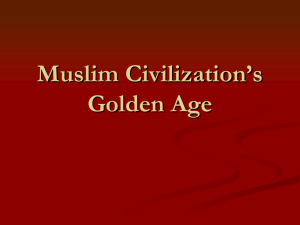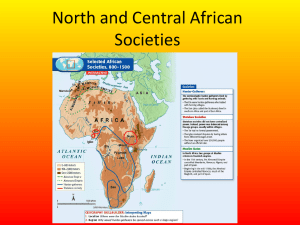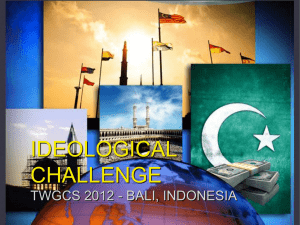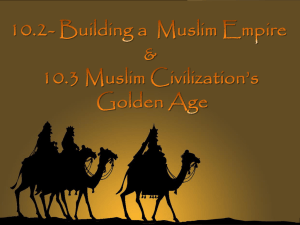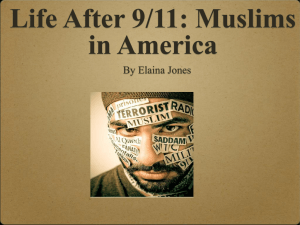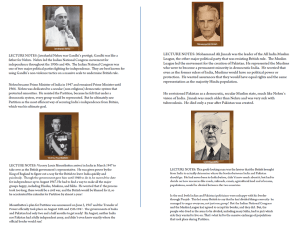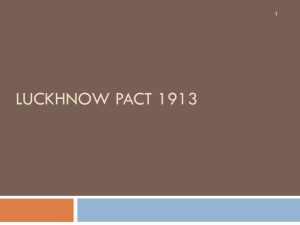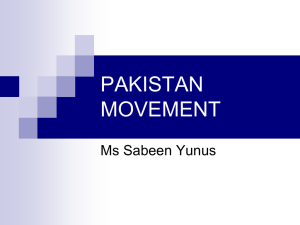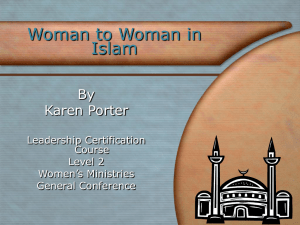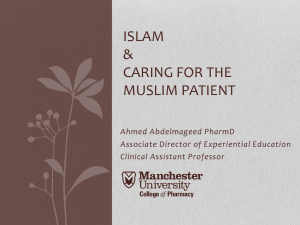Pakistan Movement - Lectures For UG-5
advertisement
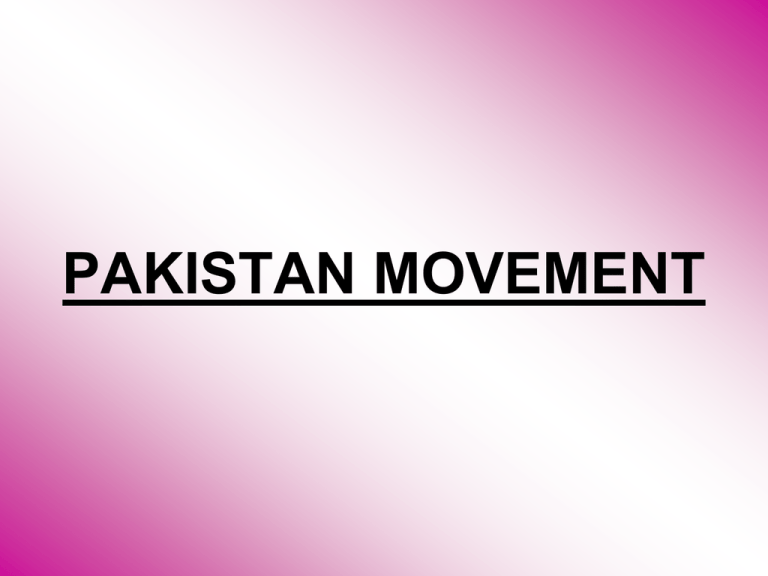
PAKISTAN MOVEMENT Indian Council Act ,1861 According to this act: • Governor general could assign special tasks to any member of the Executive Council. • Important matters were to be discussed with the Governor General. Some important subjects were kept directly under the Viceroy ,e.g., Foreign department. • Membership of the Council was raised :6 to 12.Half of them were to be non-official, nominated for two years. • The Council had limited legislative powers. In Madras and Bombay Councils approval of the Governer General (GG) and Governor was needed The Act Of 1892 • Size of Legislative Council increased. • In Central legislative Council the membership was increased 10 to 16 members.At provincial level representation was increased. In Madras & Bombay 8 -12,Bengal 12- 20. • Limited powers were given to the legislatures. Question could be asked. • Nominal election through special interests.GG and the British govt. made these appointments. Government Of India Act,1909 Minto-Marley Reforms This act provided: • Expansion of Legislative Councils Central: Additional members up to 60 but official majority remained there. • Provincial: Size varied in difference provinces .Bombay, Madras, Bengal, UP:50 Non official majority. Not all the members were elected. • Powers of the councils were increased. Now budget could be discussed. Member were allowed to present resolution and put questions. • Executive Councils were formed for Bombay, Madras & Bengal and Lt Governor Provinces. • Elections were to be held by District Boards, Municipal Committees , Zamindars and Chambers of Commerce. • Separate Electorate was accepted for minorities. Indian National Congress Indian National congress was formed to Provide a forum in which Indian Politician should meet yearly and point out to the government in what respect the administration was defective and how it could be improved. Objectives To develop harmony amongst all Indians. To improve understanding and friendship between ruler and ruled Partition of Bengal - 1905 West Bengal 54 million Hindus 42 Muslims 12 “ “ East Bengal 31 “ 12 18 “ “ Hindus Muslim Simla Deputation – 1906 Separate Electorate Allocation of more seats in legislature. Full representation in services and councils. Seats for judges in courts for Muslim’s and quota in Govt services. Aid for establishment of Muslim University. Muslim League Objective All India Muslim League was established for the furtherance of following objectives: To promote among the Muslims of India feelings of loyalty to the British Government and to remove any misconception that may arise as to the intention of the government with regard to any of the measures. Muslim League Objective To protect and advance the political rights and interests of the Muslims of India and to respectfully represent their needs and aspirations to the Government. To prevent the rise among the Muslims of India of any feelings of hostility towards other communities without prejudice to other aforementioned objects of the League. Minto-Morley Reforms – 1909 Imperial and provincial legislative councils were enlarged. The Executive councils of Bengal, Madras and Bombay were strengthened by the addition of two members in each bringing the total to four. The members of both the central and provincial legislatures were given the right of discussion and asking supplementary questions. Greater facilities were provided to the legislative members to discuss the budget. Provision were made for the discussion of matters of general public interest. Right of separate electorate was granted to the Muslims of India, thus acknowledging separate status for them. Lucknow Pact – 1916 Salient features were: The concept of separate electorate was conceded. The Muslims would have separate electorate in their majority provinces where they were not so far introduced. The Muslims would give up the right to vote and contest in the general constituency. Lucknow Pact – 1916 The Muslim weightage in the provinces as noted below should be increased. The share would be Punjab – 50%, U.P. 30%, C.P. 15%, Bombay 35%, Bengal 40%, Bihar 25%, Madras 15%. No bill affecting a particular community should be proceeded within any council, if three-fourths of the representatives of that community opposed it. Salient Features Of the Rowlatt Act • People could be tried in camera (in private) by three High court judges. • There was no right of appeal. • People could be ordered to live in a particular place. • People could be stopped from attending meetings. • People could be arrested without warrant and kept in prison without trial. The Montague-Chelmsford Reforms – 1919 National Parliament with two Houses-Council of State and Legislative Assembly. The Legislative Assembly would have 144 members of whom 103 would be elected. The two houses would pass laws and talk about the budget. The Viceroy-appointed by the British Governmentscould veto (block) any decision and bring in any law he thought necessary. Provincial Legislative Councils: the majority of members to be elected. About 5.5 million wealthy Indians out of 250 million allowed to vote. Separate electorates for Hindus and Muslims. A commission to meet after ten year to decide whether India was ready for further concession. Dyarchy : a system by which some powers were reserved and controlled by the Governor of the Provinces appointed by the Viceroy; other powers were transferred to the Provincial Legislative Councils. The Montague-Chelmsford Reforms – 1919 Transferred powers under the Reserved powers under the control of Indian Ministers control of Viceroy & Executive Councils Education. Health Service. Agriculture. Local government. Public works. Law and Order. Finance & Tex. Judges & Courts. General administration and civil service. KHILAFAT MOVEMENT Introduction Khilafat movement was a religioPolitical movement launched by the Muslims of British India for the retention of the Ottoman Khalifa and for not handing over the control of Muslim holy places to Non Muslims. Goals Ottoman Khilafat should be kept intact. Territorial solidarity of Turkey be preserved. Control of Holy Places should not be given to Non Muslims. Protests in India No participation in victory celebrations. Boycott of British goods. Non cooperation with the government in collaboration with the Congress. Non Cooperation Return titles. Boycott of courts and educational institutions. Resign from jobs. Later resign from Police and Military job. Refusal to pay taxes. Effects of Movement • The Khilafat Movement united the muslims against Britain in support of the Caliph in Turkey. • There was Hindu-Muslim unity in support of Khilafat & non-cooperation movements. • Non-cooperation led to non-violent protests all over the India. • Some protests became violent and HinduMuslim riots occurred. • The Caliphate in Turkey was abolished. • Hindu-Muslim unity came to end. • Muslim conviction were strengthened. Delhi Proposals – March 1927 Sind should be separated from Bombay and made a separate province. Similar reforms, as have been introduced in other provinces be introduced in NWFP and Baluchistan. On these conditions the Muslims are prepared to accept joint electorate in all the provinces so constituted whereas they also agree to give similar concessions and privileges to the minorities in Sind, Baluchistan and NWFP as are agreed to be granted to the minorities in the Hindu provinces. Delhi Proposals – March 1927 In the Punjab and Bengal representation should be based on population. In the Central Legislative Assembly the Muslims should have one third representation through joint electorate. Nehru Report – August 1928 Dominion status for India. Parliamentary form of Government to be introduced. No separate electorate and weightage for minorities. No Reservation of seats for Muslim except at the centre and in the province where they were in minority. One-fourth representation of Muslims in the central legislature. NWFP should be given full provincial status. Sind may be separated from Bombay and given status of province, after studying financial feasibility. Unitary form of government to be established in the centre. Hindi should be official language. The central government would comprise of a Prime Minister alongwith six ministers appointed by Viceroy. Jinnah’s Fourteen Points – March 1929 Any future constitution should be federal, with power resting with the provinces. All provinces should have the same amount of autonomy. All legislatures and local bodies should be constituted with adequate representation of minorities. Muslims should have one-third of the seats in the Central Assembly. Election should be by separate electorates. Jinnah’s Fourteen Points – March 1929 Any territorial changes should not affect the Muslim majority in Bengal, the Punjab and the NWFP. Full liberty of belief and worship shall be granted to all communities. No Bill shall be passed in any elected body if ¾ of any community in that body opposed it. Sindh shall be separated from Bombay. There should be reforms in the NWFP and Balochistan to put them on the same footing as other provinces. Jinnah’s Fourteen Points – March 1929 Muslims should have an adequate share in the services of the state. Muslim culture, education, language, religion and charities should be protected by the constitution. All Cabinets (at central or local level) should have at least 1/3 Muslim representation. The federation of India must not change laws without the consent of the provinces. Allama Iqbal Address - 1930 “I am fully convinced that the Muslims of India will ultimately have to establish a separate homeland as they cannot live with Hindus in the United India.” He further said, “The units of Indian society are not territorial as in European countries. India is a continent of human groups belonging to different races, speaking different languages and professing different religions -------- The principle of European democracy cannot be applied to India without recognizing the fact of communal groups. The Muslims’ demand for the creation of a Muslim India within India is, therefore perfectly justified.” Allama Iqbal Address - 1930 He added, “I would like to see the Punjab, NorthWest Frontier Province, Sind and Baluchistan amalgamated into a single state. Selfgovernment within the British empire or without the British empire the formation of a consolidated North-West Indian Muslim state appears to me to be the final destiny of the Muslims, at least of North-West India.” Non-cooperation Programme Surrendering of titles and resigning from seats in local bodies. Withdrawing children from government schools. Boycotting British courts. Refusing to volunteer to join the armed forces. Boycotting foreign goods. Refusing to stand for election. Declaration of Independence We believe that it is the inalienable right of the Indian people, as of any other people, to have freedom… We believe that if a government deprives a people of these rights, the people have a right to alter or abolish it… The British government ruined India economically, politically, culturally and spiritually… We believe that India must sever the British connection and attain complete independence. The Round Table Conferences The First Round Table Conference November 1930. Attendant Muslim League, The Liberals and Representative of the Princely States. The Second Round Table Conference September 1931. The Third Round Table Conference November 1932. Government of India Act – 1935 Responsible form of Government was introduced in the provinces of India. ‘Dyarchy’ was scrapped in the provinces and introduced in the centre. The subjects were distributed by drawing three lists: federal list, provincial list and concurrent list. The provincial legislature were given powers of legislation on provincial and concurrent lists. The federation was consisted of eleven provinces. Government of India Act – 1935 Every province was given a council of ministers, whose advice was binding on the Governor. Special powers were given to the governors for the protection of the rights of the minorities. Union Executive was consisted of the Governor-General and a council of ministers. The ministers were the members of legislature and appointed by the Governor General. The Governor General was appointed for a period of five years. He was responsible to the crown only. Government of India Act – 1935 The Act provided Federal Court with Jurisdiction over the states and the provinces as well. Sind was separated from Bombay. The NWFP was raised to the status of a full-fledged province. Burma was separated from India. Provincial Election - 1937 Total Seats 1585. Congress won 716. Muslim League won 109 out of 485 Muslim seats. Congress Rule Few high-handedness of Congress ministries are appended below: The Muslims were forbidden to eat beef. Every effort was made to humiliate Islam. A systematic policy was framed to erase the Muslim Culture. Hindi was enforced as official language. Azan was forbidden and mosques were attacked. Noisy procession were organized in front of mosques at prayer time. Congress Rule Pigs were pushed into mosques. Hindu-Muslim riots were maneuvered in various places to make a pretext for sever action against Muslims. Bande Matram was adopted as national anthem. Wardha Scheme and Widdia Mander schemes sought to isolate the young generation of the Muslims from their religion, culture and civilization. Congress after taking over the powers ordered the hoisting of tri-coloured flag of Congress with the British Union Jack. The Congress started a Muslim mass contact campaign with a view to crush the popularity of Muslim League. Pakistan Resolution It is the considered view of this session of the All-India Muslim League that no constitutional plan would be workable in this country or acceptable to the Muslims unless it is designed on the following basic principles. That geographically contiguous units are demarcated into regions which should be so constituted, with such territorial re-adjustments as may be necessary, that the areas in which the Muslims are numerically in a majority as in the NorthWestern and Eastern zones of India should be grouped to constitute ‘Independent States’ in which the constituent units shall be autonomous and sovereign. Pakistan Resolution “That adequate and mandatory safeguards should be specifically provided in the constitution for minorities in these units and in the region for the protection of their religious, cultural, economic, political, administrative and other rights of interests in consultation with them and in other parts of India where the mandatory safeguards shall be specifically provided in the constitution for them and other minorities for the protection of their religious, cultural, economic, political, administrative and other rights and interests in consultation with them.” Cripps Mission - 1942 During the Second World War Sir Stafford Cripps came to India with certain constitutional proposals approved by the British Govt. The major proposals of the mission are appended below: Creation of a new Indian Dominion, associated with the UK. Establishment of a constituent making body just after the end of war. Cripps Mission - 1942 Reaction to the Proposals o The all India Muslim League rejected these proposals as no separate homeland for the Indian Muslims was mentioned. o Congress rejected the plan because it demanded from the British to quit India first and them the constitutional settlement would follow. Wavell Plan – June 1945 In June 1945 the Indian Viceroy Lord Viscount Wavell held conference at Simla and proposed following proposals to Congress and Muslim leaders: An Interim Central Govt in which all portfolios except that of War would be given to the Indians. There was to be a parity of representation between the Muslims and Caste Hindus. There was a dead lock over the Muslim Leagues demand that all five members of the Executive Council should be the nominees of Muslim Leagus. Muslim Population Provinces Status Muslim (per cent) Hindus Including others (per cent) N.W.F.P SIND PUNJAB Majority 91.8 9.2 “ 70.7 29.3 “ 57.5 42.5 U.P BIHAR & ORRISA C.P Minority 15.3 84.7 “ 10.8 89.2 “ 4.7 95.3 BENGAL BOMBAY Majority 54.7 45.3 Minority 9.2 80.8 MADRAS “ 7.9 92.1 ASSAM “ 33.7 66.3 Result of the Election to the Central Legislative Assembly December 1945 Congress 57 seats. Muslim League 30 seats. Europeans 8 seats. Independents 5 seats. Akali Sikhs 2 seats. Provincial Election Result Muslim League 446/495 Muslims seats. Strength of the Muslim League in Provincial Assemblies in the Election Held in 1946 Provinces Total Muslim Seats Muslim League N.W.F.P SIND 50 36 17 60 34 28 PUNJAB U.P 175 86 79 228 65 54 BIHAR & ORRISA BENGAL 175 40 34 60 4 4 C.P BOMBAY 250 119 113 112 14 13 MADRAS 125 30 30 ASSAM 215 49 49 Cabinet Mission Plan - 1946 Salient features of Cabinet Mission Plan were as under: There would be a Union of India, comprising British India and the Indian states, which should control Foreign affairs, Defence and Communication. The Union would have an Executive and Legislature. All residuary powers would belong to the provinces. Provinces would be free to form groups with executives and legislatures. Cabinet Mission Plan - 1946 There should be three groups of provinces: Group A. Group B. Group C. Madras; Bombay, UP, Bihar, CP and Orissa. Punjab, NWFP, Sindh and Balochistan. Bengal and Assam. The Mission announced to frame an “Interim Govt” comprising representative from both congress and Muslim League. Partition Plan 3rd June, 1947 The main characters of plan were: The legislatures of Punjab and Bengal shall decide whether the provinces should be divided or not. States should be free and independent to join one or the other country. A boundary commission shall be setup which will demarcate the boundaries of the countries. Both countries shall have their own Governor Generals who will be the executive head of their respective countries. Military assets shall be divided amongst two countries after partition. Indian Independence Act 1947 On 14 July 1947, the Indian Independence bill was moved in the British Parliament which became an act on 18 July 1947. According to this act: India was to be divided into two sovereign states of Pakistan and India and the British control over India would come to an end on 15th August 1947. The princely states were given the option to join one or the other country. The act of 1935 was to remain in force until both countries draft their own constitutions.
